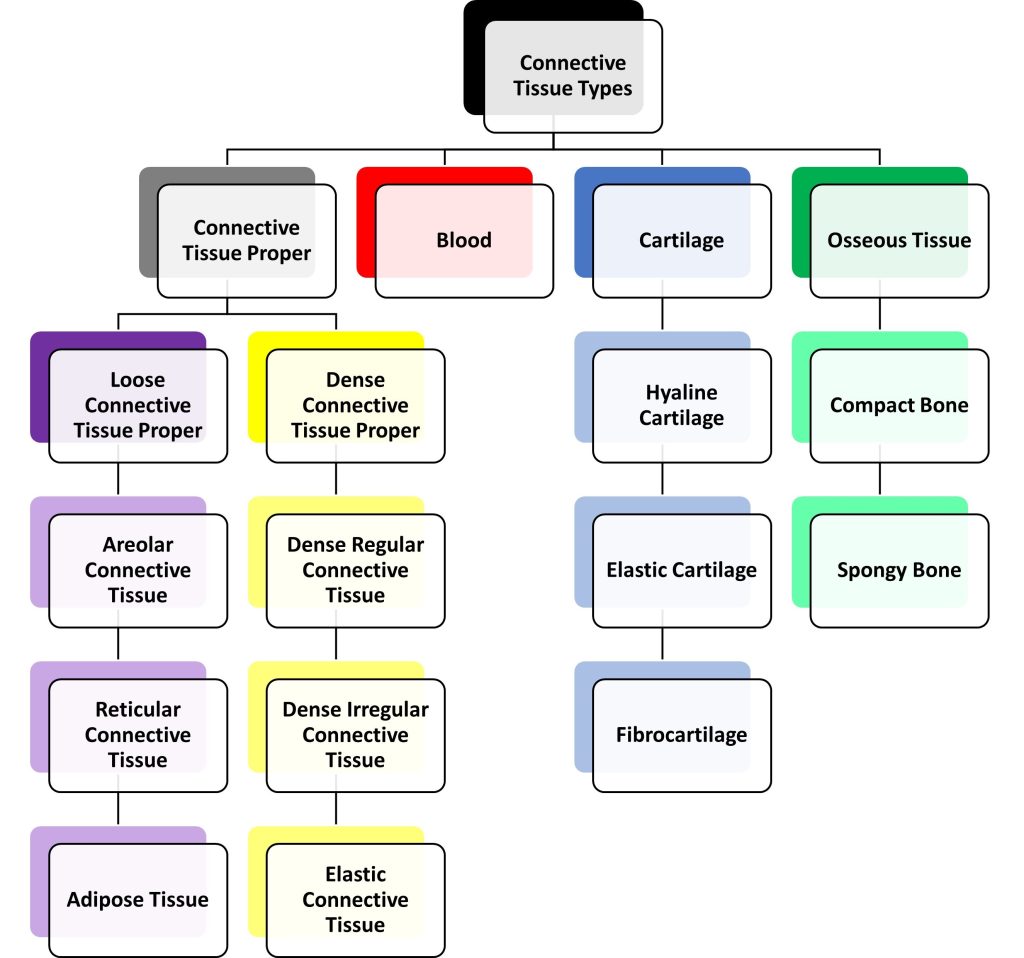Introduction to Connective Tissues
Connective tissues are a general category of tissues that bind, support, protect, insulate, and transport. In a previous chapter, The Four Major Tissue Types, we discussed the major categories of tissue types: epithelial, connective, muscle, nervous. At first glance, connective tissues may seem like a catch-all category for all tissue types that don’t fit into the other three categories (epithelial, muscle, nervous). While that may be correct, connective tissues do share some unique general characteristics.
General Characteristics of connective tissues
Examples of connective tissue in our body include really diverse tissue types like bone, blood, tendons, and fat. While these tissues seem like they don’t have much in common, all connective tissues share the following characteristics:
- Embryonic origin – all connective tissues arise from the mesenchyme (embryonic tissue)
- Variable vascularity (number of blood vessels):
- Highly vascular – bone, adipose (fat), areolar loose connective tissue
- Poorly vascular – cartilage, tendons, ligaments
- Variable extracellular matrix composition – fibrous protein and extracellular fluid/ground substance (more about this in the following section)
- Variable regeneration capacity:
- High repair capacity – osseus tissue (bone), adipose (fat) tissue, areolar loose connective tissue
- Poor repair capacity – cartilage, dense regular connective tissue (tendons, ligaments)
Structural characteristics of connective tissues
When viewing epithelial tissue, the cells form sheets and are connected to one another through specialized junctions. However, as you begin to view connective tissue, you will notice that the cells are spaced apart from one another. Between the cells is an extracellular substance called the extracellular matrix (ECM). Extracellular matrix refers to the fluid, macromolecules, and minerals that surround the cells. The matrix is made up of protein fibers, polysaccharides, extracellular fluid, minerals, and more.
The major structural macromolecule type found in the ECM are proteins, like collagen and elastin. Because these are fibrous proteins, we call them fibers. These fibers help to provide structure to the tissue, providing anchor points for embedded cells, and anchor surrounding tissue types. The protein fibers give the tissue different functions depending on the fiber type. Collagen fibers are the strongest and thickest protein fibers and help the tissue resist tension. Elastic fibers are thinner and allow for stretch and recoil of the tissue. Reticular fibers are highly branched delicate fibers creating mesh-like networks in organs mostly of the lymphatic system, where they serve as a scaffold for immune cells to move. These protein fibers are produced by fibroblasts.
The ECM consists of more than just structural protein fibers. In between this fiber meshwork is a fluid-based gel called the ground substance. Ground substance consists of soluble proteins, nutrients, ions, waste products, dissolved gasses. Another name we could give ground substance is interstitial fluid.
Types of connective tissue
There are four categories of connective tissue:
- Connective tissue proper
- Cartilage
- Osseus tissue (bone)
- Blood
The following chapters contain in-depth looks into the tissue type categories, their sub-types and their functions.
Figure 1: Types of connective tissues

The embryo has three major layers - endoderm, mesoderm, ectoderm.
loosely arranged connective tissue in the embryo that originates from the mesoderm
the ability of a tissue to repair or replenish itself
the fluid, macromolecules, and minerals that surround cells in our tissues, specifically connective tissues
a structural support system
cell type found in connective tissue that actively produces the proteins in the extracellular matrix
consists of soluble proteins, nutrients, ions, waste products, dissolved gasses
the fluid in between our cells
